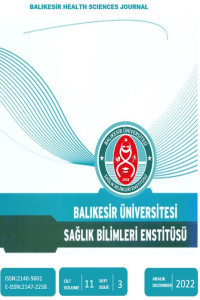ERKEĞİN KADINA YÖNELİK ŞİDDETE BAKIŞI VE TUTUMU
Şiddet, Kadına yönelik şiddet
MAN’S VIEW TOWARDS VIOLENCE AGAINST WOMEN
Violence, violence against women,
___
- 1. Watts C, Zimmerman C. Violence against women: global scope and magnitude. Lancet 2002;359:1232–7.
- 2. Heise LL, Raikes A, Watts CH, et al. Violence against women: A neglected public health issue in less developed countries. Soc Sci. Med 1994;39(9):1165–79.
- 3. Krug E, Dahlberg L, MercyJ, Zwi A, Lozano R. World Health Organization. World Report on Violence and Health: Summary.Geneva, 2002.
- 4. Gökkaya VB. Economical violence against the women in Turkey. C.Ü. Economics and Administrative Science Journal 2011; 12(2):101-112.
- 5. Güler T, Tel H, Tuncay FÖ. Women view to the violence in family. C.Ü. Medicine Faculty Journal 2005; 27(2): 51-56.
- 6. Şahin EM, Yetim D, Öyekçin DG. Prevalence of husband violence against women and women attitudes in Edirne. Cumhuriyet Medicine Journal 2012; 34:23-32.
- 7. Pınar G, Pınar T. The view of university students about the violence against women. Health and Society. 2007; 17(2):76-83.
- 8. Yaman Efe Ş, Ayaz S. Violence against women and their view . Anatolian Journal of Psychiatry 2010; 11:23-29.
- 9. Ulutaşdemir N. Violence against women. Health and Society 2002; 12(4):15-20.
- 10. Tanrıverdi G, Şıpkın S. In Çanakkale, educational level of the women who Consult Health Center. Fırat Medicine Journal 2008; 13(3):183-187.
- 11. T.C.Presidency of Family Research Association(2000). The Reasons and Results of Violence in Family. Ankara.
- 12. Fikree F.F, Razzak J.A, Durocher j. Attitudes of Pakistani men to domestic violence: a study from Karachi, Pakistan. JHMG 2005; 2(1):49-58.
- 13. Page A.Z, İnce M. A Compilation about the violence in family. Turkish Psychology Essays 2008; 11 (22): 81-94.
- 14. Gage AJ, Hutchinson PL. Power, control, and intimate partner sexual violence in Haiti. Arch Sex Behav. 2006;35(1):11-24
- 15. Arıkan Ç. Poverty, Lack of Harmony, Divorce. Ankara: şafak Printery (page AZ)
- 16. Vung ND, Ostergren PO, Krantz G. Intimate partner violence against women in rural Vietnam: different socio-demographic factors are associated with different forms of violence. Need for new intervention guidelines? BMC Public Health. 2008; 8(1):55.
- 17. Ellsberg MC, Peña R, Herrera A, Liljestrand J, Winkvist A.Wife abuse among women of childbearing age in Nicaragua. Am J Public Health 1999; 89:241-4.
- 18. Choi SY, Ting KF. Wife beating in South Africa: an imbalance theory of resources and power. J Interpers Violence. 2008; 23(6):834-52.
- 19. Parish WL, Wang T, Laumann EO, Pan S, Luo Y. Intimate partner violence in China: national prevalence, risk factors and associated health problems. Int Fam Plan Perspect. 2004;30(4):174-81.
- 20. Peek Asa C, Zwerling C, Young T, Stromquist AM, Burmeister LF, Merchant JA. A population based study of reporting patterns and characteristics of men who abuse their female partners. Inj Prev. 2005; 11(3):180-5.
- 21. Dönmez G. Determing The Existence of Violence and its Types and Factors Among the Married Men.İzmir, Dokuz Eylül University, Medicine Faculty Society Health Department Branch Thesis,2008.
- 22. Yağbasan M, Ustakara F. The study of determining the communication in coffeehouse in Turkish Society (Example of Gaziantep). Fırat University Social Science Journal 2008; 18(1):233-260.
- ISSN: 2146-9601
- Yayın Aralığı: Yılda 3 Sayı
- Başlangıç: 2012
- Yayıncı: Balıkesir Üniversitesi
YAŞLI BiREYLERDE DiŞETi OLUĞU SIVISI OSTEOKALSiN SEViYESiNiN DEĞERLENDiRiLMESi
Sabri Fatih KURŞUNLU, Veli Özgen ÖZTÜRK, Mehmet Zahit BAŞ
İNTRAPANKREATİK LİPOM: GÖRÜNTÜLEME BULGULARI
Erdoğan BÜLBÜL, Bahar YANIK KEYİK, Murat YILDAR, Gülen DEMİRPOLAT, Bahri KEYİK
Semra KARACA, Ünsal BARLAS, Nevin ONAN, Yüksel Can ÖZ
PERİODONTAL HASTALIKTA YAŞLILIK İLE KEMİK MARKIRLARININ İLİŞKİSİ
Sabri Fatih KURŞUNLU, Veli Özgen ÖZTÜRK
HEMŞİRELERİN İŞ YAŞAMI KALİTELERİ İLE HASTA MEMNUNİYETİ ARASINDAKİ İLİŞKİNİN İNCELENMESİ
Ruşen ÖZTÜRK, Duygu GÜLEÇ, Sezer ER GÜNERİ, Ümran SEVİL, Nalan GÜRMEN
HEMŞİRELİKTE ELEŞTİREL DÜŞÜNMENİN KLİNİK KARAR VERMEYE ETKİSİ
SAĞLIK ÇALIŞANLARININ SAĞLIĞI VE GÜVENLİĞİ
Ayşe Meydanlioğlu AYŞE MEYDANLIOĞLU
ERKEĞİN KADINA YÖNELİK ŞİDDETE BAKIŞI VE TUTUMU
A Gökçe DEMİR, Gizem Deniz BULUCU, Ayşegül ÖZCAN
HİPERTANSİYONLU BİREYLERDE TAMAMLAYICI VE ALTERNATİF TEDAVİ KULLANMA DURUMU
Şefika Dilek GÜVEN, Gamze MUZ, Nuriye Efe ERTÜRK, Ayşegül ÖZCAN
ÜNİVERSİTE ÖĞRENCİLERİNİN “PIERCING”E YÖNELİK BİLGİ VE TUTUMLARI
Dilek Çakır UMAR, Filiz ÖĞCE, Yeliz Çakır KOÇAK, Zehra BAYKAL AKMEŞE
